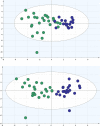Frequency domain shows: Fall-related concerns and sensorimotor decline explain inability to adjust postural control strategy in older adults
- PMID: 33216812
- PMCID: PMC7678972
- DOI: 10.1371/journal.pone.0242608
Frequency domain shows: Fall-related concerns and sensorimotor decline explain inability to adjust postural control strategy in older adults
Abstract
Human postural control is a complex system and changes as we age. Frequency based analyses have been argued to be useful to identify altered postural control strategies in balance tasks. The aim of this study was to explore the frequency domain of the quiet stance centre of pressure of older adults with various degrees of fall-related concerns and sensorimotor functioning. We included 45 community dwelling older adults and used a force plate to register 30 seconds of quiet stance with eyes open and closed respectively. We also measured sensory and motor functions, as well as fall-related concerns and morale. We analysed the centre of pressure power spectrum density and extracted the frequency of 4 of its features for each participant. Orthogonal projection of latent structures-discriminant analysis revealed two groups for each quiet stance trial. Group 1 of each trial showed less sensory and motor decline, low/no fall-related concerns and higher frequencies. Group 2 showed more decline, higher fall-related concerns and lower frequencies. During the closed eyes trial, group 1 and group 2 shifted their features to higher frequencies, but only group 1 did so in any significant way. Higher fall-related concerns, sensory and motor decline, and explorative balancing strategies are highly correlated. The control system of individuals experiencing this seems to be highly dependent on vision. Higher fall-related concerns, and sensory and motor decline are also correlated with the inability to adjust to faster, more reactive balancing strategies, when vision is not available.
Conflict of interest statement
The authors have declared that no competing interests exist.
Figures




Similar articles
-
Predicting balance impairments in older adults: a wavelet-based center of pressure classification approach.Biomed Eng Online. 2023 Aug 22;22(1):83. doi: 10.1186/s12938-023-01146-3. Biomed Eng Online. 2023. PMID: 37608334 Free PMC article.
-
Increased postural sway during quiet stance as a risk factor for prospective falls in community-dwelling elderly individuals.Age Ageing. 2017 Nov 1;46(6):964-970. doi: 10.1093/ageing/afx083. Age Ageing. 2017. PMID: 28531243
-
Decline in sensorimotor systems explains reduced falls self-efficacy.J Electromyogr Kinesiol. 2018 Oct;42:104-110. doi: 10.1016/j.jelekin.2018.07.001. Epub 2018 Jul 9. J Electromyogr Kinesiol. 2018. PMID: 30015133
-
Assessment of postural balance in community-dwelling older adults - methodological aspects and effects of biofeedback-based Nintendo Wii training.Dan Med J. 2014 Jan;61(1):B4775. Dan Med J. 2014. PMID: 24393594 Clinical Trial.
-
Falls and Balance Impairments in Older Adults with Type 2 Diabetes: Thinking Beyond Diabetic Peripheral Neuropathy.Can J Diabetes. 2016 Feb;40(1):6-9. doi: 10.1016/j.jcjd.2015.08.005. Epub 2016 Jan 6. Can J Diabetes. 2016. PMID: 26778679 Review.
Cited by
-
Cognitive functions explain discrete parameters of normal walking and dual-task walking, but not postural sway in quiet stance among physically active older people.BMC Geriatr. 2024 Oct 19;24(1):849. doi: 10.1186/s12877-024-05425-z. BMC Geriatr. 2024. PMID: 39427183 Free PMC article.
-
Balance Adaptation While Standing on a Compliant Base Depends on the Current Sensory Condition in Healthy Young Adults.Front Hum Neurosci. 2022 Mar 25;16:839799. doi: 10.3389/fnhum.2022.839799. eCollection 2022. Front Hum Neurosci. 2022. PMID: 35399363 Free PMC article.
-
Specific Posture-Stabilising Effects of Vision and Touch Are Revealed by Distinct Changes of Body Oscillation Frequencies.Front Neurol. 2021 Nov 22;12:756984. doi: 10.3389/fneur.2021.756984. eCollection 2021. Front Neurol. 2021. PMID: 34880823 Free PMC article.
-
Feasibility and Effectiveness of a Novel Intervention Integrating Physical Therapy Exercise and Dance Movement Therapy on Fall Risk in Community-Dwelling Older Women: A Randomized Pilot Study.Healthcare (Basel). 2023 Apr 12;11(8):1104. doi: 10.3390/healthcare11081104. Healthcare (Basel). 2023. PMID: 37107938 Free PMC article.
-
Physical Frailty Prediction Using Cane Usage Characteristics during Walking.Sensors (Basel). 2024 Oct 28;24(21):6910. doi: 10.3390/s24216910. Sensors (Basel). 2024. PMID: 39517806 Free PMC article.
References
-
- Shumway-Cook A. Motor control: translating research into clinical practice. 3 ed., Baltimore, Md: Baltimore, Md: Lippincott Williams & Wilkins; 2007.
-
- Lord SR. Falls in older people risk factors and strategies for prevention. New York: Cambridge University Press; 2001.
Publication types
MeSH terms
LinkOut - more resources
Full Text Sources
Medical

